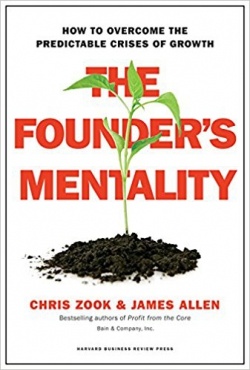 Book
Book
Zook, Chris and James Allen. “The Founder’s Mentality: How to Overcome the Predictable Crises of Growth.” (2016). Harvard Business Review Press.
Reviewer
Dr. Michael Boehlje, Professor Emeritus Department of Agricultural Economics
Summary
The start-up and early stages of growth and expansion of any new business is an exciting time to say the least: new opportunities, new challenges, and new risks. Successful businesses capture the opportunities, meet the challenges, manage the risks and, over time, grow to be a significant competitor in their market and industry. However, as they mature from the start-up/new venture phase of the business life-cycle, these successful businesses often become more complex, more bureaucratic, and more conservative in their decision making.
What this means for food and agribusiness
If this natural maturing process occurs at the same time that changes are happening in the business climate, as is now the case in the food and agribusiness sector, (i.e., consolidation and mergers and acquisitions in input manufacturing and retailing, as well as food processing and distribution; new disruptive technology including digitization and automation across the entire value chain; and new asset-lite business models, such as FBN that are “amazoning” the retail distribution system) the growth process can transition from the excitement of opportunity to the fear of failure. Zook and Allen describe this as the crises of growth-overload, stall-out and, in some cases, free-fall. Studies of long-term survivability/success in almost all industries indicate that it is rare for a firm to not encounter the crises of growth—and many don’t survive it.
So how might one respond to the crises of growth? How might you reignite the passion and reenergize the organization that suffers from overload, stall-out or free-fall? Zook and Allen argue in their book The Founder’s Mentality: How to Overcome the Predictable Crises of Growth,that returning to one’s roots is critical.
They identify the roots of the Founder’s Mentality as:
- Insurgency
- Frontline obsession
- Owner’s mindset
Figure 1 from Zook and Allen (p. 35) provides a synopsis and more detail for each of these roots as well as specific ways to reestablish the critical elements of the Founder’s Mentality.
How can you as a leader of your organization guide and help your management team recognize the crises of growth and reestablish the Founder’s Mentality? Here are nine actions you can take (Zook and Allen, pp 165-183):
- Pursue “opposities” simultaneously – It is not easy to do, but successful growing businesses must be able to increase their size (i.e., grow) and continue to be agile (i.e., responsive to changing market conditions and customer expectations).
- Say no to say yes – Carefully evaluate opportunities that are outside your core areas of focus and competencies/capabilities and reserve your resources for those opportunities that best fit what you are really good at.
- Make 10X investments – Resist the tendency to spread your financial and human resources too broadly and thinly. Be willing to make a “beg bet” to renew and reenergize your core.
- Pursue the root cause – We frequently tend to observe symptoms of unacceptable performance and not dig deep enough to identify the root cause of the stall out from growth. Use the “five why’s” questioning process to drill down to the real cause of the problem.
- Invest heavily in next-generation leadership – the “graying” of the management team in most agribusiness companies combined with a historical underinvestment in mid-career managers has combined to result in a next-generation management vacuum in too many cases.
- Invest preemptively in building new capabilities – at the same time as investing in next-generation leadership is required, investing more broadly in the capabilities and capacities of the current workforce is also critical. Differentiation and competitive advantage will increasingly come from the soft assets, not the hard assets, and leadership and talent management will be essential to build these assets.
- Focus on long-term goals and horizons – we all struggle with the immediacy syndrome – short-term pay-off goals and financial performance metrics, wanting quick results, investing in short-term projects that may not create long-term value. As growth slows down, the tendency is to double-down on projects/activities/investments that will give a quick pop to current earnings or market share. The founder’s mentality mindset recognizes that short-term survival is essential, but the focus is always on long-term value creation.
- Become guardians of speed and agility – now the dichotomy – maintain and enhance the ability to respond quickly to changing conditions and the capability to be agile rather than bureaucratic in the decision process. All while focusing on long-term goals rather than short-term financial performance.
- Share the burden of leadership across the organization – leadership can and should come from all levels of the organization; from the support staff, the sales force, the research lab, the manufacturing floor, the loading dock, the truck drivers- and not just from the C-suite.





